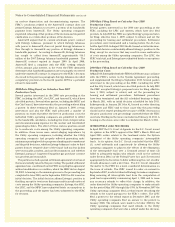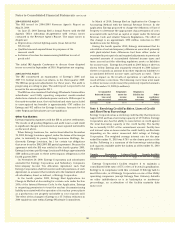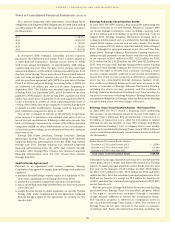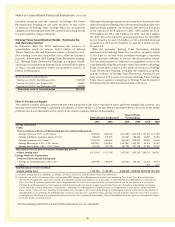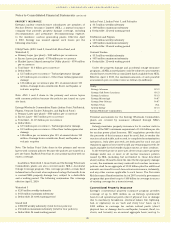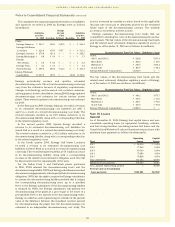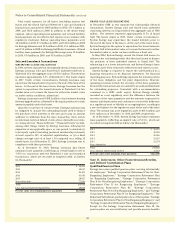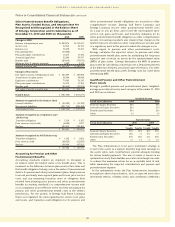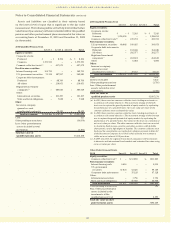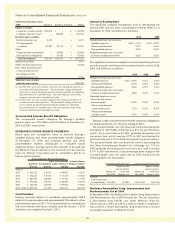Entergy 2010 Annual Report Download - page 90
Download and view the complete annual report
Please find page 90 of the 2010 Entergy annual report below. You can navigate through the pages in the report by either clicking on the pages listed below, or by using the keyword search tool below to find specific information within the annual report.
Notes to Consolidated Financial Statements continued
Comprehensive Income
Accumulated other comprehensive income (loss) is included in
the equity section of the balance sheets of Entergy. Accumulated
other comprehensive income (loss) in the balance sheets
included the following components (in thousands):
December 31, 2010 December 31, 2009
Cash flow hedges net
unrealized gains $ 106,258 $ 117,943
Pension and other
postretirement liabilities (276,466) (267,939)
Net unrealized investment
gains 129,685 72,162
Foreign currency translation 2,311 2,649
Total $ (38,212) $ (75,185)
Other comprehensive income and total comprehensive
income for years ended December 31, 2010, 2009, and 2008 are
presented in Entergy’s Statements of Changes in Equity and
Comprehensive Income.
Note 8. Commitments and Contingencies
Entergy and the Registrant Subsidiaries are involved in a number
of legal, regulatory, and tax proceedings before various courts,
regulatory commissions, and governmental agencies in the
ordinary course of business. While management is unable to
predict the outcome of such proceedings, management does
not believe that the ultimate resolution of these matters will
have a material adverse effect on Entergy’s results of operations,
cash flows, or financial condition. Entergy discusses regulatory
proceedings in Note 2 to the financial statements and discusses
tax proceedings in Note 3 to the financial statements.
Vidalia Purchased Power Agreement
Entergy Louisiana has an agreement extending through the
year 2031 to purchase energy generated by a hydroelectric
facility known as the Vidalia project. Entergy Louisiana made
payments under the contract of approximately $216.5 million
in 2010, $204.9 million in 2009, and $166.5 million in 2008. If the
maximum percentage (94%) of the energy is made available
to Entergy Louisiana, current production projections would
require estimated payments of approximately $170.2 million in
2011, and a total of $2.64 billion for the years 2012 through 2031.
Entergy Louisiana currently recovers the costs of the purchased
energy through its fuel adjustment clause. In an LPSC-approved
settlement related to tax benefits from the tax treatment of the
Vidalia contract, Entergy Louisiana agreed to credit rates by
$11 million each year for up to ten years, beginning in October
2002. In addition, in accordance with an LPSC settlement, Entergy
Louisiana credited rates in August 2007 by $11.8 million (including
interest) as a result of a settlement with the IRS of the 2001 tax
treatment of the Vidalia contract. Entergy Louisiana agreed to
credit ratepayers additional amounts unless the tax accounting
election was not sustained. During the years 2013-2031, Entergy
Louisiana and its ratepayers would share the remaining benefits
of this tax accounting election. The provisions of the settlement
also provide that the LPSC shall not recognize or use Entergy
Louisiana’s use of the cash benefits from the tax treatment in
setting any of Entergy Louisiana’s rates. Therefore, to the extent
Entergy Louisiana’s use of the proceeds would ordinarily have
reduced its rate base, no change in rate base shall be reflected
for ratemaking purposes.
Nuclear Insurance
THIRD PARTY LIABILITY INSURANCE
The Price-Anderson Act requires that reactor licensees purchase
insurance and participate in a secondary insurance pool that
provides insurance coverage for the public in the event of a
nuclear power plant accident. The costs of this insurance are
borne by the nuclear power industry. Congress amended and
renewed the Price-Anderson Act in 2005 for a term through 2025.
The Price-Anderson Act requires nuclear power plants to show
evidence of financial protection in the event of a nuclear accident.
This protection must consist of two layers of coverage:
1. The primary level is private insurance underwritten by
American Nuclear Insurers and provides public liability
insurance coverage of $375 million. If this amount is not
sufficient to cover claims arising from an accident, the
second level, Secondary Financial Protection, applies.
2. Within the Secondary Financial Protection level, each nuclear
reactor has a contingent obligation to pay a retrospective
premium, equal to its proportionate share of the loss in
excess of the primary level, regardless of proximity to the
incident or fault, up to a maximum of $117.5 million per
reactor per incident (Entergy’s maximum total contingent
obligation per incident is $1.3 billion). This consists of a
$111.9 million maximum retrospective premium plus a five
percent surcharge, which equates to $117.5 million, that may
be payable, if needed, at a rate that is currently set at $17.5
million per year per incident per nuclear power reactor.
There is no limitation for terrorist acts as there had been in
the past.
Currently, 104 nuclear reactors are participating in the
Secondary Financial Protection program. The product of
the maximum retrospective premium assessment to the nuclear
power industry and the number of nuclear power reactors
provides over $12.2 billion in secondary layer insurance
coverage to compensate the public in the event of a nuclear
power reactor accident. The Price-Anderson Act provides
that all potential liability for a nuclear accident is limited to the
amounts of insurance coverage available under the primary and
secondary layers.
Entergy Arkansas has two licensed reactors and Entergy
Gulf States Louisiana, Entergy Louisiana, and System Energy
each have one licensed reactor (10% of Grand Gulf is owned by
a non-affiliated company (SMEPA) that would share on a pro-
rata basis in any retrospective premium assessment to System
Energy under the Price-Anderson Act). The Entergy Wholesale
Commodities segment includes the ownership and operation of
six nuclear power reactors and the ownership of the shutdown
Indian Point 1 reactor and Big Rock Point facility.
88


